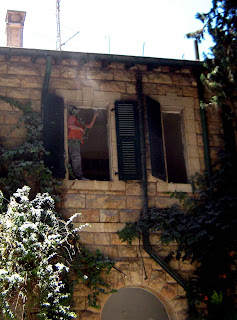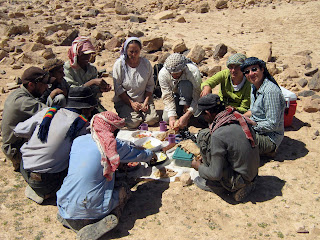Once again in Amman, I spent my time making arrangements for my upcoming two-week excavation season at Humayma and traveling around the country to visit sites that I had not been to for years. I also bought a new lap top computer to replace my old one that had died recently.
It proved remarkably easy to make the arrangements for my upcoming excavation. I needed to make a couple of trips to the Department of Antiquities to get my excavation permit, which the director has the habit of not issuing more than a couple of days before the start of a project. But otherwise things went smoothly. One of the members of the dig team is Isabelle Rubin, a free-lance archaeologist who has lived in Jordan for years. She was a big help in making arrangements. Two other members of the dig team also arrived in Jordan to spend some time touring before the start of the excavation. They are Ilse Sturkenboom and Anja Heidenreich, both connected with the University of Bamberg in Germany.
On April 14 I went with Isabelle, Ilse and Anja on a trip to visit the site of Humayma and find an apartment to rent for the two week season; we took a load of dig equipment along with us. We traveled along the Dead Sea-Araba highway and stopped for lunch near Feinan.
 Isabelle, Anja and Ilse at our picnic spot near Feinan.
Isabelle, Anja and Ilse at our picnic spot near Feinan.
We then continued along the scenic road up to Petra, which I had not been on since 1993, before it was nicely paved. We continued to Quwayra, where we met the landlord of an apartment building that Isabelle knew about, and I decided to rent an apartment there. We then stopped by the site of Humayma to see the current state of the area where we will soon be excavating. I did some of the driving back to Amman. It was the first time I had driven a manual transmission vehicle in years, but the trip passed without incident.
The next day, April 15, I began a few days of travel around the country to visit sites. I went with Zdravki Dimitrov, one of the current ACOR fellows, to visit some sites in the south part of Amman, first to Quwaysma to see the location of the Byzantine period church that I had excavated in 1989; the church was demolished shortly thereafter so that the landowner could built a modern house on the spot, so nothing remains of the church.

The house where the Quwaysma church used to be before 1989
We also went to find the second upper church at Quwaysma, only to discover that it too was almost totally destroyed by recent construction. We then went to the rock-cut tomb on the south side of Amman, where Muslim tradition locates the Cave of the People of the Cave, mentioned in the Quran. We then went to find the Byzantine church in Swafieh; I had never figured out before where it was located exactly. We found the modern shelter built over the church, but it was locked; we would have needed to make arrangements with someone from the Department of Antiquities to visit it.
On April 16 I visited more sites south of Amman with Zdravki and Robert Darby, another of the current ACOR fellows. We wanted to visit Qasr al-Tuba, one of the Umayyad desert palaces, but we were unable to locate it. It turns out that it is off the paved road, some distance from where we thought it was. We did get to two other Umayyad desert palaces, however: Khan al-Zabib and Qastal; a lot of work has been done at Qastal since I was last there. Qastal has what may be the earliest preserved minaret tower.

The minaret tower at Qastal
On April 17 I did more traveling, this time with Susan Graham, one of the fellows at the Albright Institute. I went to meet her at the Jordanian side of the Allenby Bridge and we went to the nearby site where tradition has it Jesus was baptised. The Jordanians have been developing the site extensively for religious tourism, but it is remarkably unimpressive.

The baptism site
In the afternoon we went to Jerash, where Susan was especially interested in the Byzantine period churches. Burton MacDonald, a long-time colleague, joined us. The mosaic floor in the Bishop Isaiah church was recently uncovered. I had not seen it exposed before, so I took a lot of photographs of the floor with its examples of the curious deliberate damage to the images of animals and people.
 An example of the deliberate damage to an image in the mosaic floor of the Bishop Isaiah church
An example of the deliberate damage to an image in the mosaic floor of the Bishop Isaiah church
On April 18 I did more traveling with Susan Graham to visit sites with Byzantine churches in the northern part of the country. We went to Umm al-Jimal, where I had worked in 1984.

The Numerianos Church at Umm al-Jimal where I had worked in 1984
We then went to Umm al-Surab, Sama and Mafraq. We continued on to Hayyan al-Mushrif and then Rihab, Khirbat al-Samra and Yajuz, seeing in the course of the day more Byzantine churches than you could shake your fist at. I was disappointed to see how many churches the Department of Antiquities has thoughtlessly cleared in recent years.

Susan Graham at the baptistery of one of the churches at Hayyan al-Mushrif
On April 19 Susan returned to Jerusalem and I then spent my time making arrangements for the upcoming excavation.










 Steve in his square
Steve in his square 


 Me and the watermelon
Me and the watermelon  Ghassan, Isabelle and Spiderman
Ghassan, Isabelle and Spiderman
 Haroun, our department representative, and Saleh, our landlord
Haroun, our department representative, and Saleh, our landlord The landscape, including a herd of sheep and goats
The landscape, including a herd of sheep and goats  Steven making a sand angel
Steven making a sand angel
 Quwayra as seen from the roof of our apartment building
Quwayra as seen from the roof of our apartment building The Ottoman fort at Quwayra
The Ottoman fort at Quwayra
 Fig. 2. General view of the C119 church
Fig. 2. General view of the C119 church







 Isabelle, Anja and Ilse at our picnic spot near Feinan.
Isabelle, Anja and Ilse at our picnic spot near Feinan. 


 An example of the deliberate damage to an image in the mosaic floor of the Bishop Isaiah church
An example of the deliberate damage to an image in the mosaic floor of the Bishop Isaiah church 


 George Hintlian and one of the Armenian mosaic floors on the Mount of Olives
George Hintlian and one of the Armenian mosaic floors on the Mount of Olives  Detail of the Armenian mosaic floor near Damascus Gate
Detail of the Armenian mosaic floor near Damascus Gate
 The Visitor Center at Umm al-Rasas
The Visitor Center at Umm al-Rasas 



